2014 Growing Season
2014 Growing Season
-
-
-
-
-
2014 Growing Season
-
Post #1 - May 5th, 2014, 10:55 pmI have a little free time, and this Spring hasn't gotten too hectic yet, so I'll start another follow along thread. This is going to start off slow, because if I don't start it now, it won't get done, and the first thing I know, it'll be Winter again.
Here we go.........
We usually don't like to do too much real work on Sunday, but I count working up the garden, and gardening in general, as more fun than work, so I started Spring tillage.
Two trips over it with a field cultivator and it looked like this:
A little further back, for scale:
The chickens are out there, feeding on worms, in the freshly turned dirt.
I hit it this morning with a Harrogator (a big spike tooth drag), so it's all ready to plant, but I didn't take pictures, I'll try to get some in the morning. The soil temp is still pretty cool, but it's supposed to warm up by the end of the week. I think I'll at least try to get some sweet corn planted in the next couple of days. Hopefully, it'll warm up enough that if we get rain, the new sprouts won't rot in the cool dirt.
We have new chicks coming May 14th. The new pigs will probably arrive as soon as we get enough rain, that my feeder pig guy gets driven out of the field for a few days. I'm still waiting to hear back from a few customers about the increased price, due to PEDv, that we will have to pass along. So far, everyone is seeing the increase already at the grocery store, so they understand it will happen with us too.
We are still trying to decide if we want to mess with raising some turkey's for Thanksgiving. There is a niche market there, but I don't know if I really want to be a poultry guy. If we decide to do it, you'll get to follow along.
Well, I think we've taken care of Gardening and Farming, time for Foraging.......
I grew up in a family that ate dandelion greens every Spring. I never liked them as a kid, but as I get older, I crave them after a long Winter. Usually one or two fixin's will do me.
Today was the first one, NW Ohio comfort food: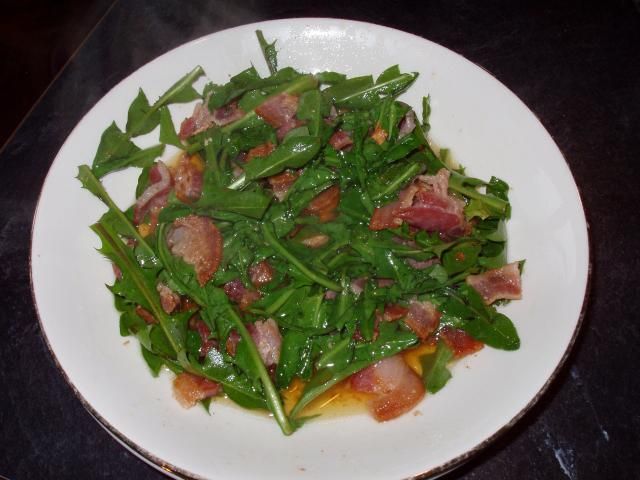
My wife tries them every time I make them, but she has yet to be a fan....... oh well, more for me. I waited too long to gather the young growth, it was pretty hard to find, so this might be the only mess of greens I get this year. It should satisfy my urge until next year.
I think that's it, the growing season is still young, we will be getting busier in the next few weeks. Hopefully I can post regular updates of plants and critters growing out here in God's country.
Thanks for following along this far.......
Tim
-
-
Post #2 - May 6th, 2014, 7:37 amTwo saturdays ago it was warm enough and dry enough for me to turn my little veg plot (16x8') I added 12 bags (3/4 cubic foot each) of topsoil (Menards' was of very nice quality, no twigs or rocks at $1.17/bag), and 4 of compost and manure, since there had been some receding along the edge. Covered with plastic again over 3/4 of it, and planted a row each of lettuce, peas and gai lan, which all said could be planted before the last frost. Seedlings are just starting to appear. I have seeds for basil and lacinato kale to go in when it's a bit warmer, and plan on picking up some tomato, chile and tomatillo plants for my salsa patch.What is patriotism, but the love of good things we ate in our childhood?
-- Lin Yutang
-
-
Post #3 - May 8th, 2014, 11:20 pmJoelF wrote:Two saturdays ago it was warm enough and dry enough for me to turn my little veg plot..... .... Seedlings are just starting to appear........
My wife planted a couple little beds about the same time. She told me today at dinner that she could see plants coming.
Time for a picture laden update, although none of them are really about the growing season.....
We'll start with this one: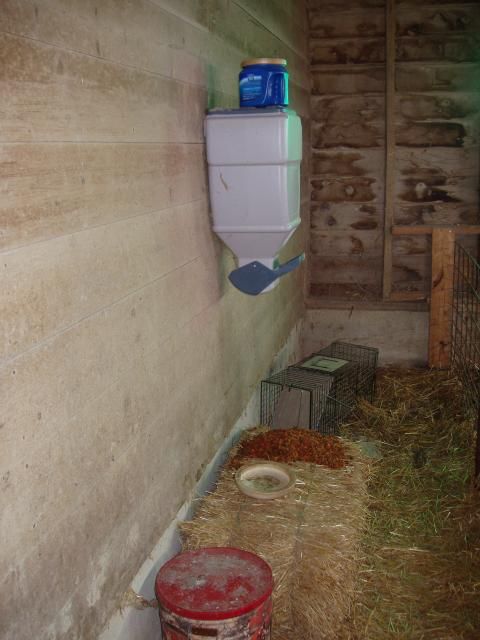
I found this, this morning, when I was feeding the cats in the barn. The bin on the wall holds the cat food. The bale underneath it is where we feed our original barn cat. It looks like we had a raccoon climb up on the bale, reach up over 30 inches, and open the door on the bin, spilling all the cat food. The box trap in the background was used last winter, catching another masked bandit, that had been knocking food bowls over and spilling water, before it was able to freeze solid. We hadn't had evidence of another coon until the last couple days, when things started looking askew...... and then this act of vandalism.
I hung the trail camera up, so I'll try to catch the varmint in the act, the next time he opens the bin.
Next up..... we feed our other barn cat in the hay mow. Last summer, a stray showed up and had kittens in one of our other sheds. She was really wild and we'd just catch a glimpse of her from time to time. The kittens disappeared when she weaned them, but we'd see them once in awhile on the edge of the fields. We haven't seen any of them since winter. Well, the mother showed back up in the hay mow, the middle of winter and seems to have made herself at home. She will actually allow us to touch her, when she's hungry enough that food is more important than fear. She hisses and spits at us, but if you ignore her and keep reaching, she'll let you touch her.
I've seen blurs of movement the last week or so, running behind bales, but this morning, I caught this little guy sitting in the open. Mom in front, kid in rear......
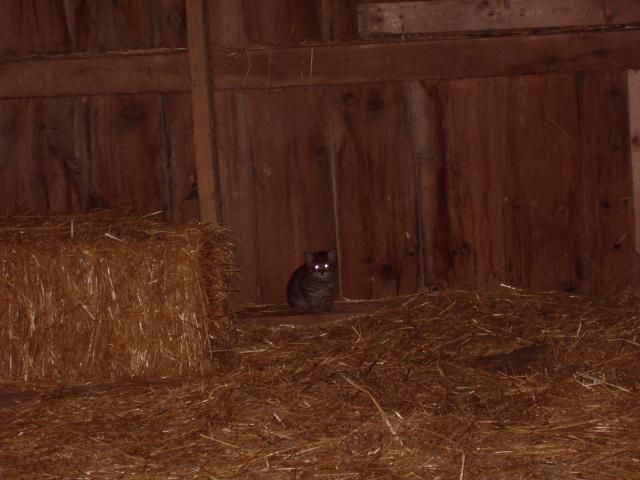
Tonight, I decided to go out and walk around, since the temps have warmed enough to be out in shirtsleeves. I went in the main barn and found this in the rafters.....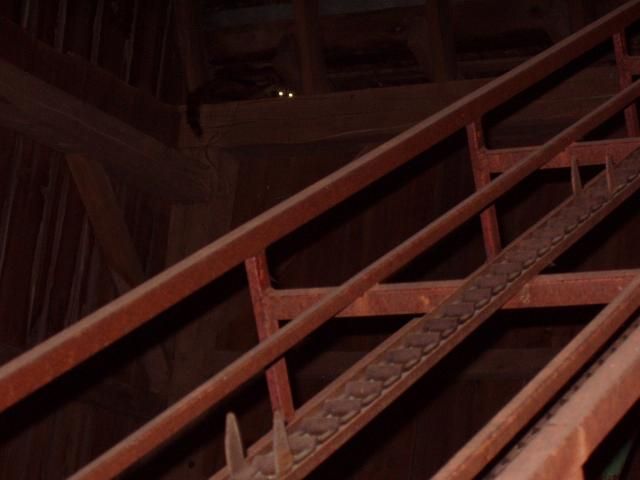
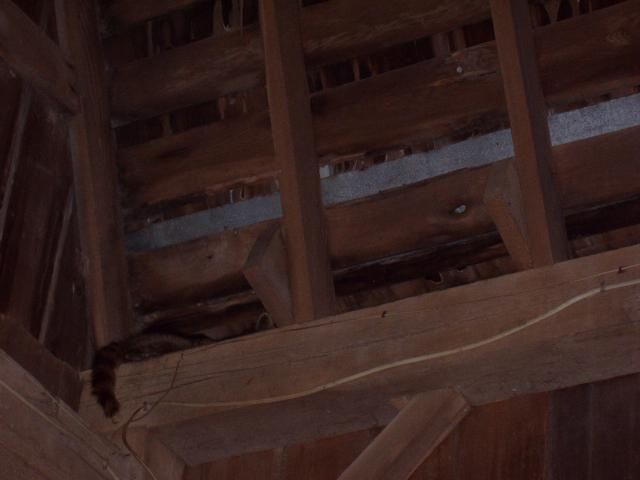
I don't think he's big enough to be the cat food culprit, but that just means I have more than one unwanted critter in the barn.
As long as I was in there, I climbed up in the mow to check things out. Mother cat was up there, and these little guys were behind her: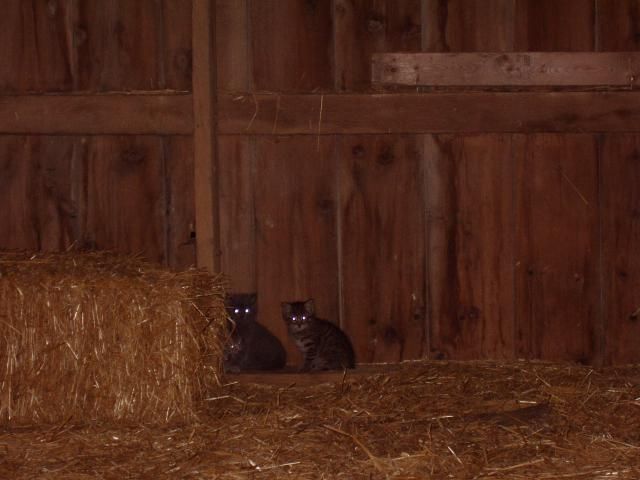
If you look close, there are three kittens. I only saw two, when I was up there, until I downloaded the pictures and counted the glowing eyes.
So I think that's it. The garden is about 1/3 planted, peas, green beans, sweet corn and pop corn are all in the ground waiting for rain. We should get that in the morning, I just hope it's an all day soaker and not a 30 minute downpour. We'll plant the rest of the garden as soon as the temperature gets a little warmer and stays there. The rest of the space will be filled with bedding plants; peppers, pickles, cukes, tomatoes, zukes, squash, etc.
Most of the field corn is planted in the area, and I'd guess about 1/4 of the soybeans. I think everybody is hoping for rain, so we can get a break and bring what's already in the ground.
Thanks for following along, next post should have pigs and chicks, for a more farmy feel.
Tim
-
-
Post #4 - May 9th, 2014, 7:46 amTim-
I love your updates. Thanks for sharing.-Mary
-
-
Post #5 - May 9th, 2014, 9:24 amHigh speed update.
Looks like our talented, high reaching coon was back last night: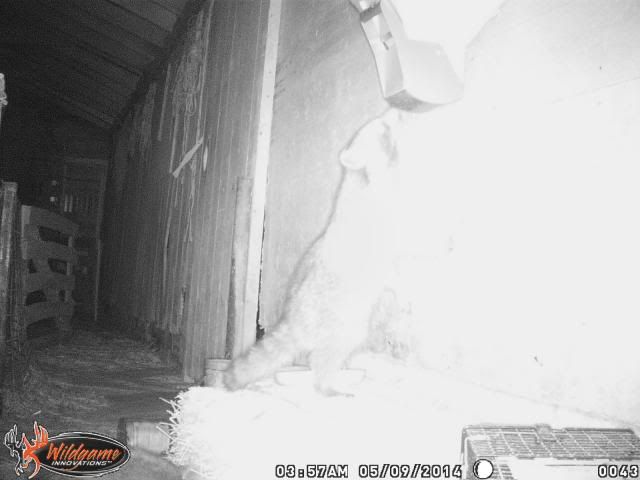
He brought a couple of his buddies along: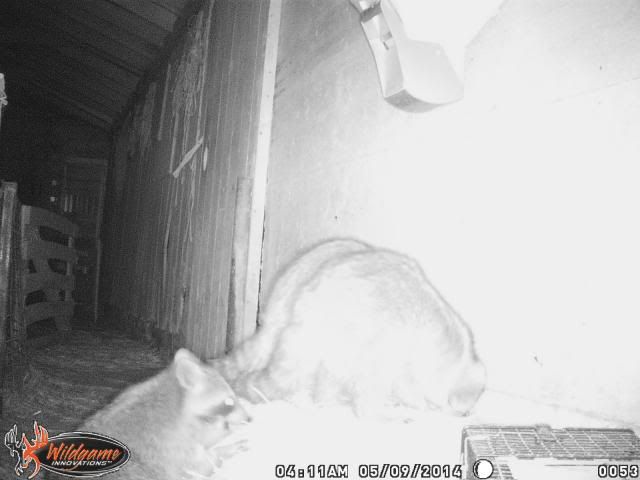
Looks like we aren't a single species habitat. Lower left corner, partially covered by the camera logo, a little opossum action: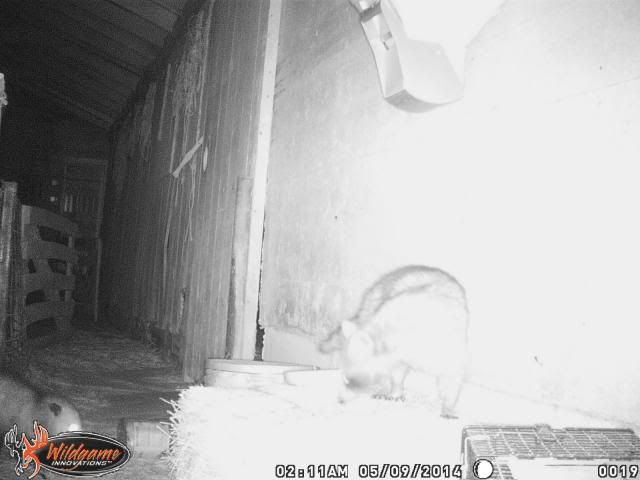
Looks like it might be time to set the trap. I saw a skunk fooling around in the yard a week or so ago, I really don't want to deal with him in a trap. I may have to leave the camera up for a few days to make sure what's running around out there.
Tim
-
-
Post #6 - May 12th, 2014, 9:12 amBack to gardening........
Our first rhubarb harvest from our own patch: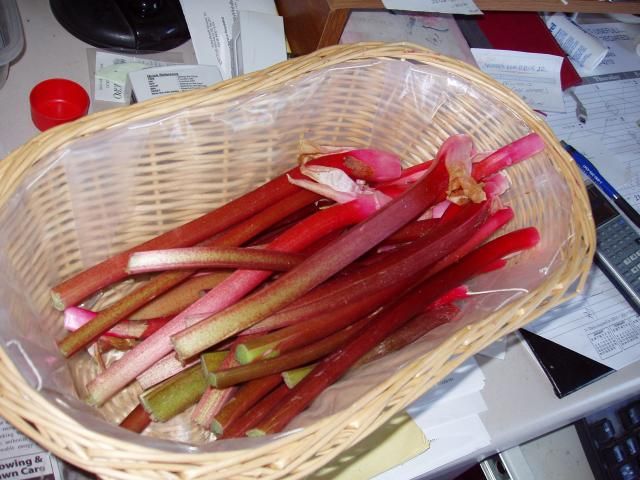
We got some starts from Denise's uncle, in Michigan, in 2011. 2012 brought the drought and it just hung on for the year, it didn't thrive. Last year it did pretty well, but we wanted it to have a good year of growing before we picked any. This was the year, we didn't get alot, but it was enough for a pan of rhubarb crisp to take to mom's and a little extra for sauce on ice cream.
Luckily, we have friends who usually have extra, so we'll get enough for our freezer, until our patch gets going full tilt.
We got a nice half inch of rain last night. The peas we planted Good Friday had a few random plants sticking out yesterday, last nights shower popped most of the rest out of the ground.
You can see a couple of crooked rows if you look close:
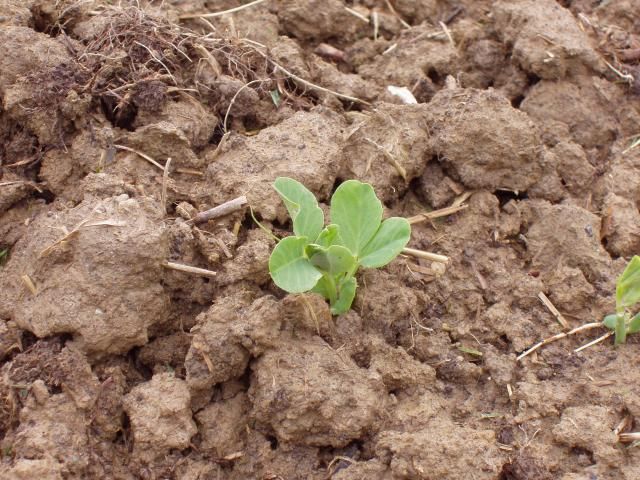
Last picture, for the hope of things to come........
The strawberries are blossoming, won't be long and we'll have to take care of them.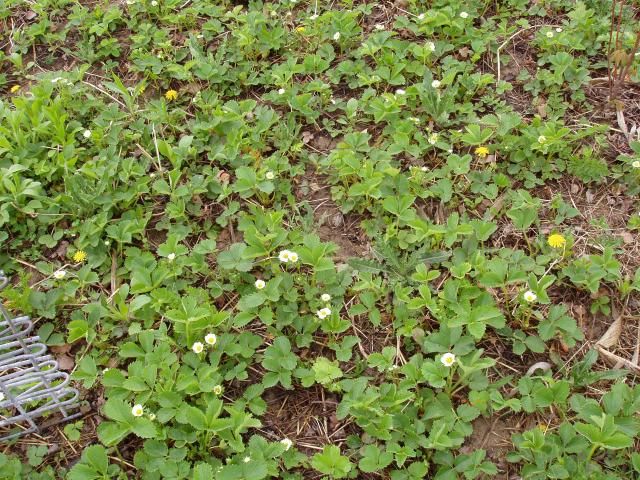
We are getting everything ready for the arrival of the new chicks Wednesday morning. With this rain, I'm sure the pigs will be here by the end of the week.
Tim
-
-
Post #7 - May 14th, 2014, 11:32 amThe new chicks arrived about an hour ago:
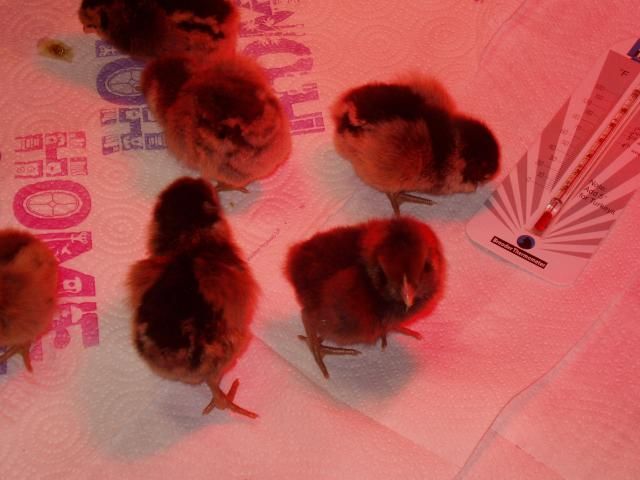
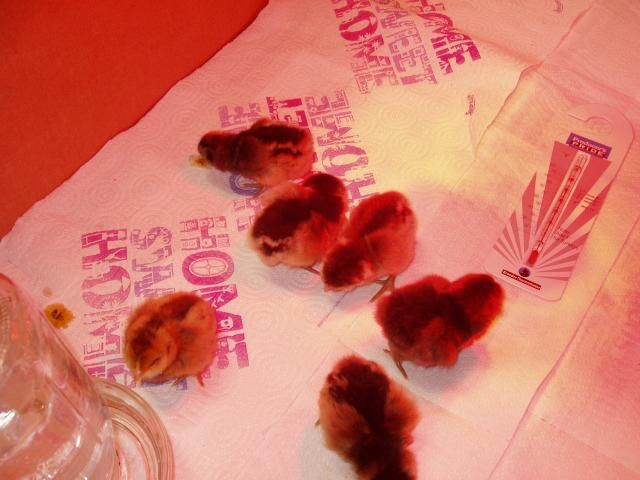
They are Araucanas, they should lay pastel colored eggs when they mature. We had three in our first batch of hens and only one would lay blue eggs, the rest were just brown like the Barred Rocks.
They've all had a drink and have discovered the food, they are starting to snooze under the heat lamp, always a good sign when you first get them home.
-
-
Post #8 - May 14th, 2014, 11:41 amLove their welcome paper!!!"Knowledge is knowing a tomato is a fruit; wisdom is not putting it in a fruit salad." Miles Kington
-
-
Post #9 - May 14th, 2014, 9:34 pmLOL ~ The chicks are in my shop, I usually have a few generic rolls of paper towels out there. I ran out just before I got the bottom covered, so I grabbed some from out of the house. I didn't even notice what it was until you mentioned it, I just knew they were fancier than what I usually have out there.
The little hens seem to be settling in well tonight. I'd prefer to not have cold wet weather on the first day, but we'll take what we get.
Tim
-
-
Post #10 - May 20th, 2014, 10:29 pmTime for a late night, picture laden update. No pigs yet, my buddy got hit hard with 4-H & FFA kids this Spring, buying pigs for the area fairs. Keeping his barn full comes first, so ours are coming next week.
Plenty of new critters to see though......
The chicks are growing, one week old and already getting pin feathers. It seems like these are eating more and gowing faster than usual: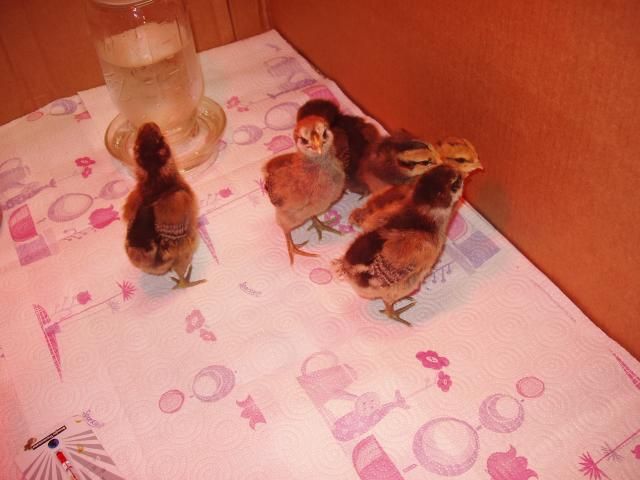
The Swallows have been back for a couple of weeks. Last years nest is filled again....
..... and there is a second pair......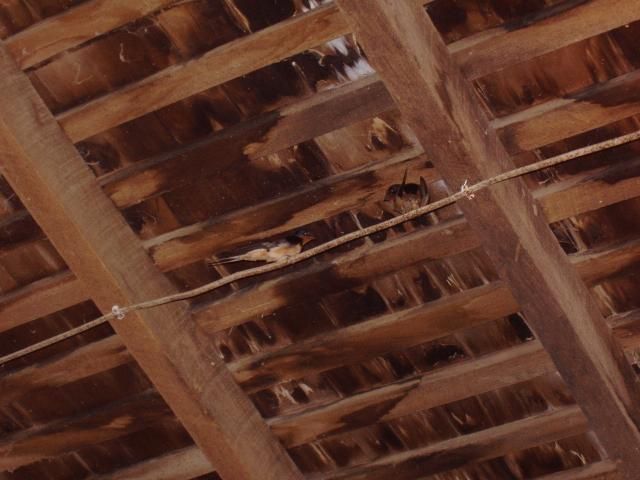
....they are still building, but haven't moved in yet....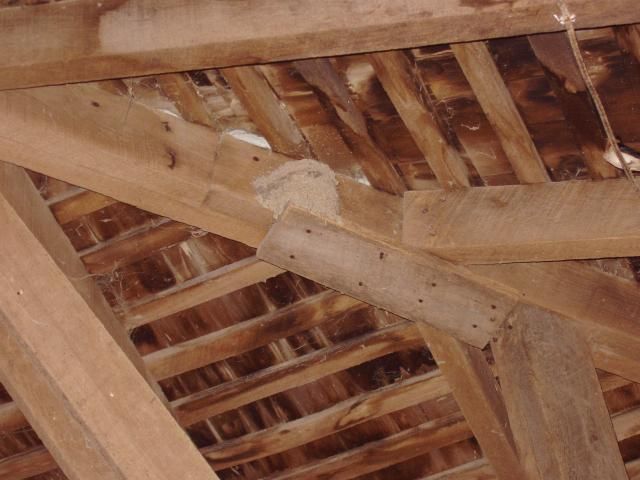
I was closing the barn up this evening, preparing for the storms headed our way, when a third pair flew in like they owned the place....... we'll see what happens.
Last pictures of the week. Last Sunday, my wife saw the kittens heading througn the grass going from one barn to the other. She managed to catch two: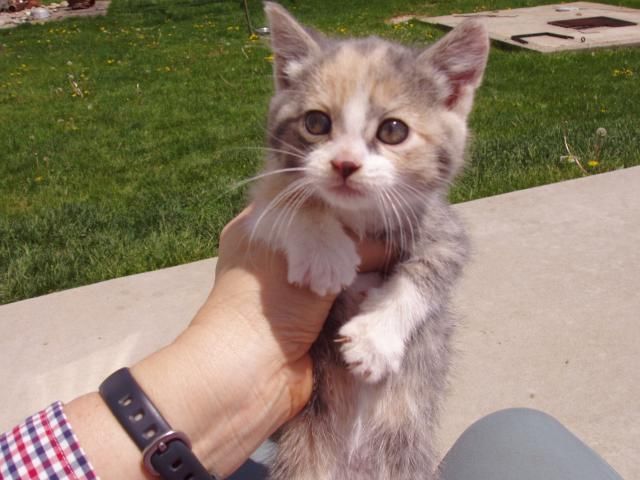
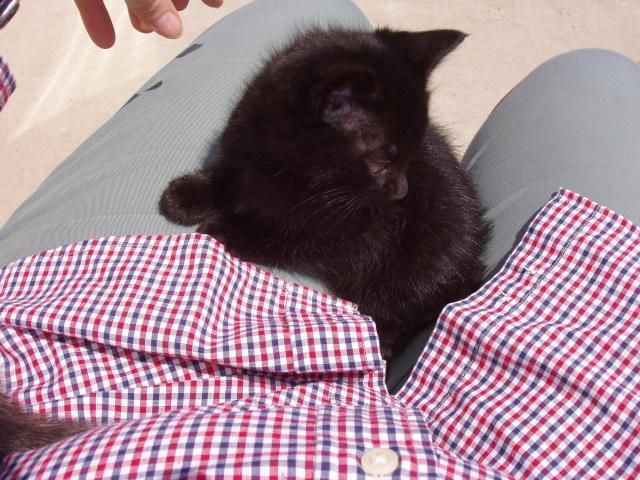
There are 5 all together. They look happy to be held, but they are really wild. The calico looking one was growling pretty much the whole time it was being held. The black one has been caught a couple of more times since, it seems to be getting used to us.
I think that's it, it's been a boring week. We are watching the storms come across Indiana, hoping they aren't too bad. We still have enough moisture, another week of dry would get the rest of the crops in the ground and everybody could relax a little..... all part of the fun I guess.
Tim
-
-
Post #11 - May 21st, 2014, 6:27 pmIt is such a pleasure to read your posts. I have such a tiny garden and I garden vicariously through your wonderful account of farm and fleet. Thank you.What disease did cured ham actually have?
-
-
Post #12 - May 26th, 2014, 10:46 pmI'll try to post more in the morning, we spent the weekend up north at my in-laws. The best part of the weekend.......
the hunt for the elusive shrooms......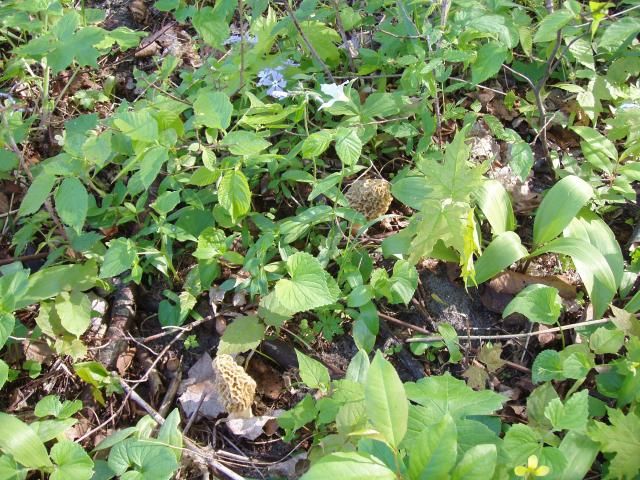
We left for home early this morning. We are supposed to get rain tonight, so I wanted to get some plants in the garden.
We got home about 2pm. We worked outside until about 8. My wife got quie a few flower beds cleaned up and replanted, and I got most of the garden finished.
Looks like the rain is almost here, I'm glad we pushed to get done what we did.......
I'll try to post a real update tomorrow, I have a ton of pictures to show everybody.
Last one for this reply,
My wife says I still have a way with the ladies, they'll follow me anywhere.....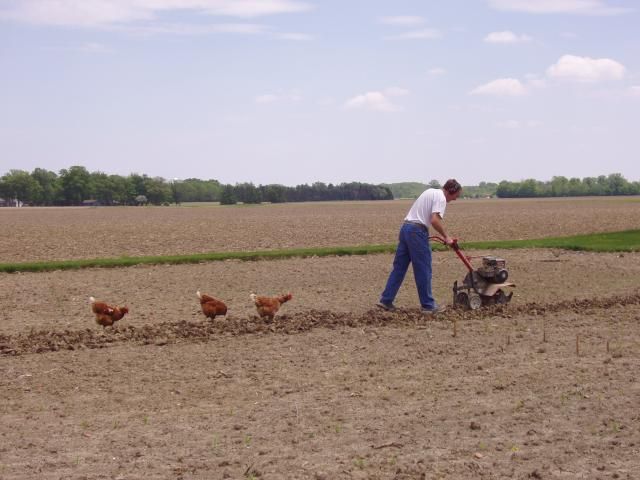
....more tomorrow.....
Tim
-
-
Post #13 - May 27th, 2014, 9:31 amI have some free time before dinner, so I'll post some pictures.
We spent the weekend in Northern Michigan at my in-laws. Saturday was spent in the secret mushroom grounds, on my wife's uncle's farm. This was the take after the first spot was searched: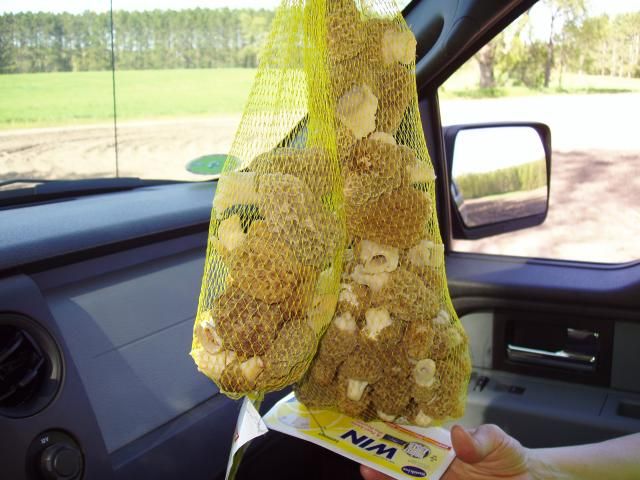
For anyone who hasn't looked for the elusive Morel's, this is what they look like in the wild: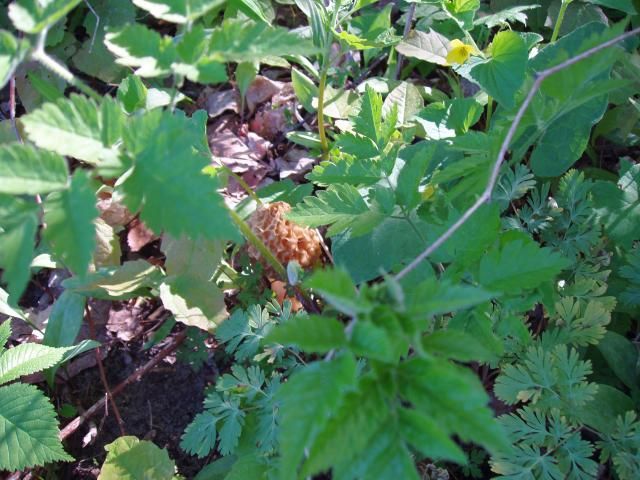
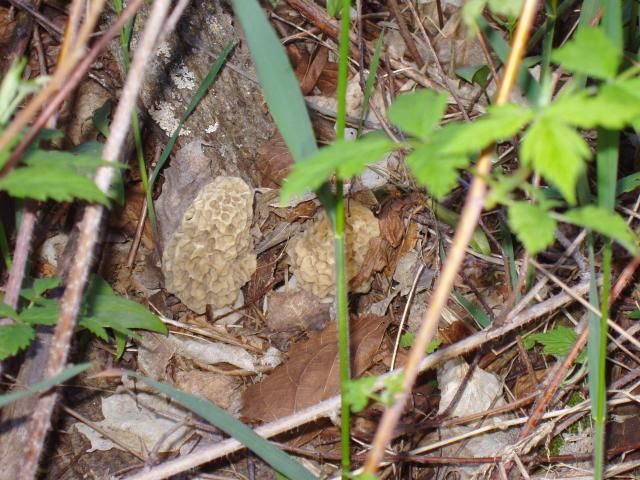

And this is what they look like after they are found....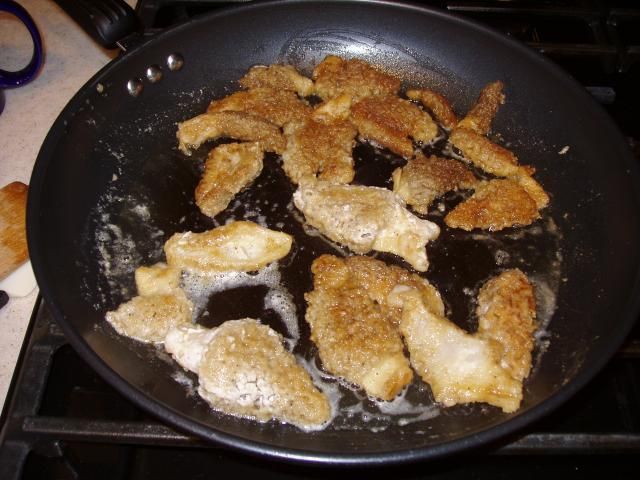

We shared with the family, for breakfast Sunday, and the rest came home with us. I think we were about a week late, but it was the best harvest we've had in 5 or 6 years.
We left early Monday. because rain was forecast and we wanted to get bedding plants in the garden. When we left home, you could see the corn was up, but it wasn't big enough to see rows. They are hard to see in the picture, but there are green rows there: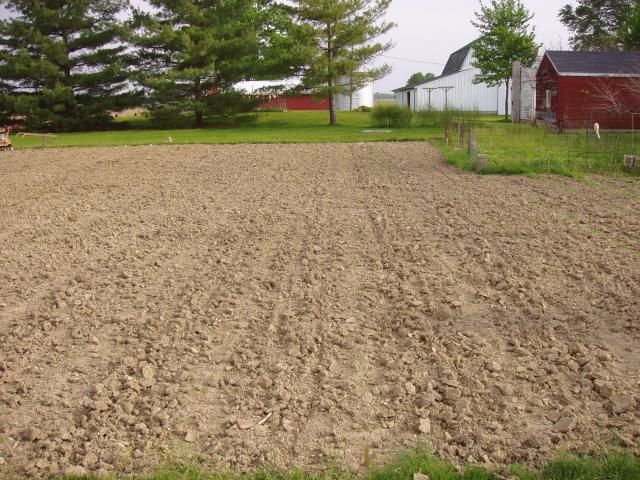
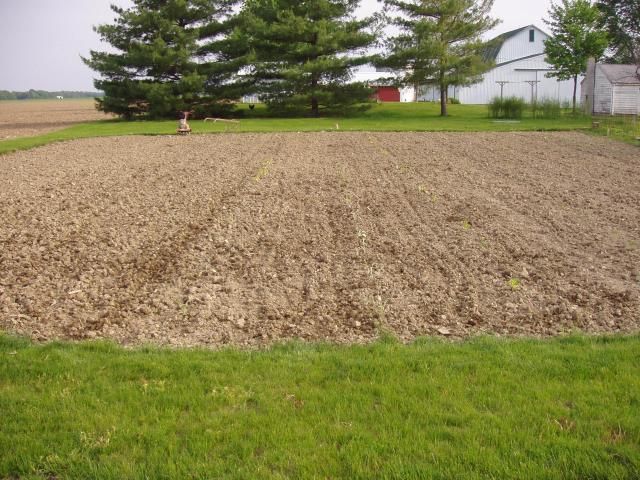
The peas are easier to see: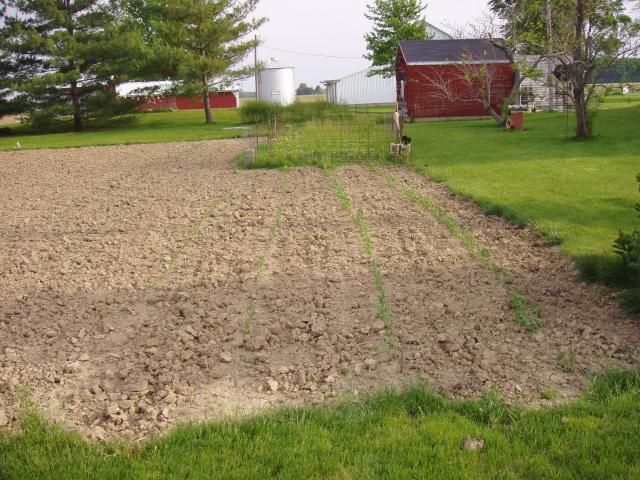
When we quit last night, we had summer squash, tomatoes, jalapenos, cabbage, kalorabi, cukes, and pickles planted. I also planted 5 more rows of sweet corn. The rain missed us last night, so I ran and got zukes, cauliflower and butternut squash this morning, and just got them in the ground. We still have a little room left, my wife will get the rest of the plants tonight or tomorrow.
Our local hardware store closed last winter. They had a little greenhouse and we always got our bedding plants from them. We have been forced to search for what we need this year. There are plants around, but they aren't always as nice as what we are looking for. Looks like the rains this evening will be more widespread, so we probably won't get missed again. We'll get the rest of the garden filled up after it dries out.
Last picture, the chicks really grew while we were gone, the neighbor must have taken good care of them....
Pigs are coming Saturday, I'll be getting the barn ready the rest of the week, rain or shine.
Thanks for looking.
Tim
-
-
Post #14 - May 30th, 2014, 8:51 amThe new porkers have finally arrived!! We are hoping for a good growing season now, so the price of feed doesn't go through the roof. The price of these little guys is up over 50%. Luckily, the price of feed has dropped enough, we can offset that increase, and hopefully get them out the door for the same price as the group last fall.
I've prepared all our customers for the worst, and they understand. Just another one of the benifits of knowing our consumers and them knowing us.
Anyhow, the new arrivals, just a few minutes after walking off the trailer.....
Tim
-
-
Post #15 - June 1st, 2014, 2:05 amWell, we spent the day outside, gettting yardwork and gardening caught up. The garden is almost full, I think we have everything in that we need. We still have room for a couple more rows, we'll probably fill them up with something odd, that catches our eye, the next time we are looking at bedding plants.
We got the chicks outside today, for the first time. We didn't leave them out too long, but they got to discover grass and sunshine for the first time in their lives. They didn't run around much, just sat and enjoyed the sun.
Krazy Kat was gaurding the chicks when they first got outside. I'm pretty sure if one escaped, she wouldn't make it very far.....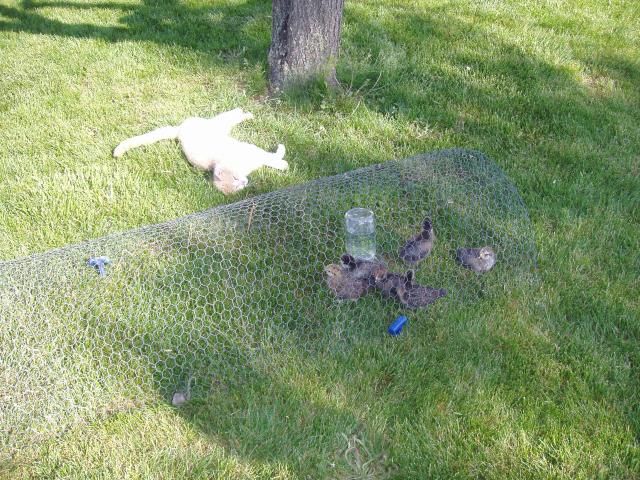
They should be just about feathered out by next week. They are really growing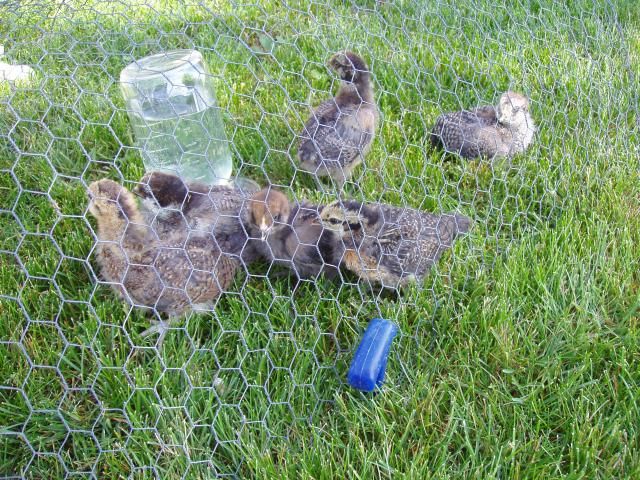
The pigs are doing well, still settling in and getting used to the new surroundings.
Supposed to get a couple days of rain the first of the week, hopefully it comes slow and gentle. We have had a really nice spring so far and the fields are coming up nice and even.
Not much else to show right now, if we get a shot of rain, the garden should really grow. I'm hoping for more & better pictures next time.
Tim
-
-
Post #16 - June 4th, 2014, 10:18 pmMidweek update...... we finally got some much needed rain this morning/afternoon. We ended up with 4/10", it was just a nice gentle rain. We could have taken a little more, as easy as it came, but beggers can't be choosy, that'll do us for a few days.
Took a couple of pictures of the garden, just after the rain started, the dark ground helps to see the growth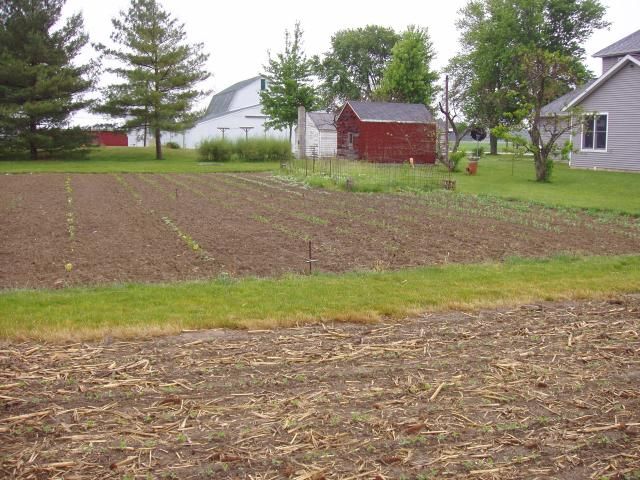
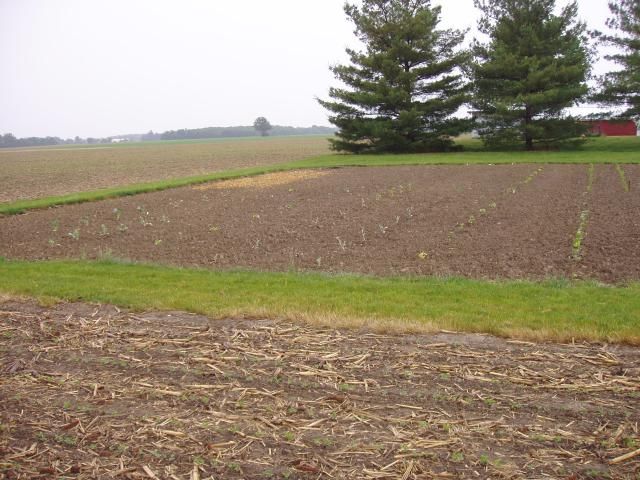
Next stop was the barn. The new pigs are still getting used to us. They still stay clear of us when we are in the pen, but my wife got one to come up to her tonight, so she could touch it's nose. The first few days in a new barn usually makes them kind of cautious and jumpy. Today when I walked in, I noticed a couple of them were messing with a cat that was walking down the aisle. They are starting to chase each other around and play a little too, so they are settling in.
Comfortable/happy pigs means they gain faster (rate of gain) and eat less doing it (feed conversion), that's a fact that's true in the biggest confinement barns down to our little operation. Pretty much everyone, looks at these numbers to see how good their management practices are.
Anyhow, the pigs...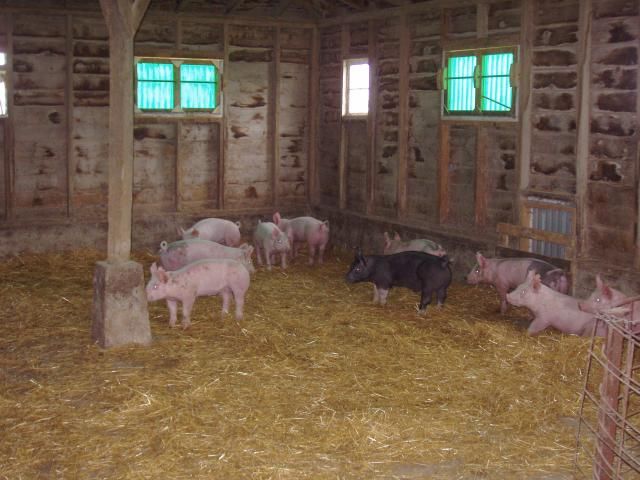
Last picture is another swallow nest. I didn't notice this one until I started getting the pen ready for pigs. It's right inside the door. We have three nesting pairs in the barn this year, two pair in new nests. I'm pretty excited about that, they say the common barn swallow is struggling because of lack of habitat. We'll take all of them that want to move in. They'll have plenty of flies to eat in a another couple of weeks.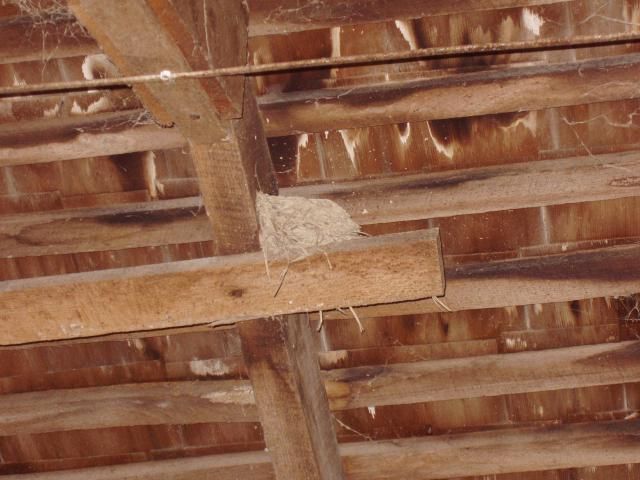
I think that's it, my picture of the new chicks was blurry, so I'll get another one in a day or two.
Thanks for following along....
Tim
-
-
Post #17 - June 5th, 2014, 7:16 pmLove this thread. LOVE.. Reminds me of being a 4-H kid back in the day, out in Kane County. Thanks so much for posting these!
-
-
Post #18 - June 5th, 2014, 7:58 pmI'm going to save this thread so that when I'm ready to retire to my little country farm, I can follow this step by step. Inspiration. Thank you!!"Knowledge is knowing a tomato is a fruit; wisdom is not putting it in a fruit salad." Miles Kington
-
-
Post #19 - June 5th, 2014, 9:49 pmKeep posting-please! I am truly in awe of your efforts and dedication. Our garden is on hiatus -we have had so many things come up this month and the weather was such a negative factor. If we delay any more we may consider crop rotation and compost the patch this year. Sad.What disease did cured ham actually have?
-
-
Post #20 - June 6th, 2014, 12:53 pmHi Tim,
Another fan. Farming captures all the senses and there is something romantic about that to me.
I don’t know how to do what you do, so I find your posts intriguing.
There is just something comforting about your writing and your photos. They reflect your passion and your efforts.
Thank you.
-
-
Post #21 - June 7th, 2014, 11:46 pmThanks for the kind words, it's nice to know our everyday life is interesting to people in the big city.
My original goal, for becoming a member on LTH Forum, was to be a resource for where food comes from. I hope I'm accomplishing that mission. Feel free to ask anything, if you think it's a stupid question, send me a Private Message and I'll answer out of the public view. If I can make one or two people out there, at least question, some of the misinformation that's circulating, about what we eat, my time here is well spent.
On with the update......
The chicks got a long day outside today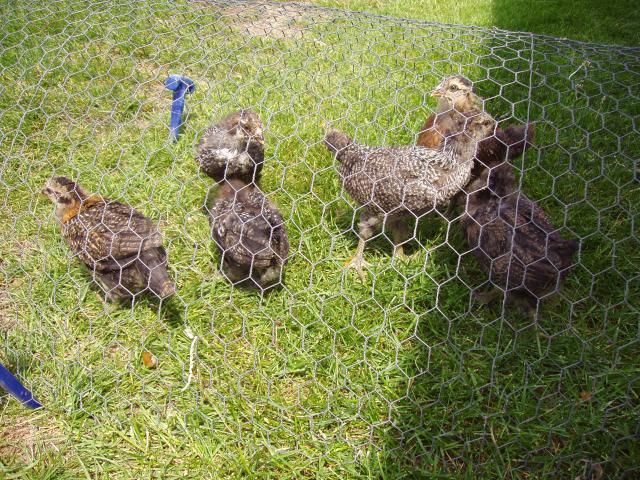
They were in the sun for about 2 minutes, when they started streatching out and enjoing the rays
I need my shop back, they'll be moving to the coop pretty soon, hopefully by the end of the week.
We spent the day doing a thorough lawn mowing. The last couple of weeks, we have just gotten the grass cut, to stay ahead of it. Today, we trimmed and cleaned and weeded until the place looks like it's for sale. Too bad it will only last for about two days and it will be looking shabby again.
My wife finished the afternoon in the strawberry patch. I haven't been paying attention, but she has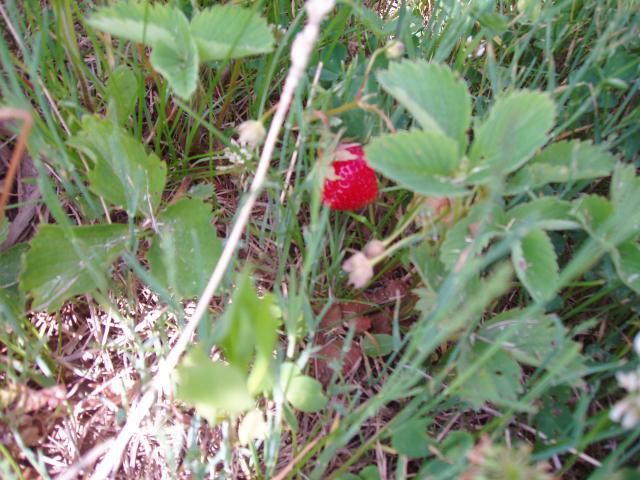
It's still pretty early, but she got two quarts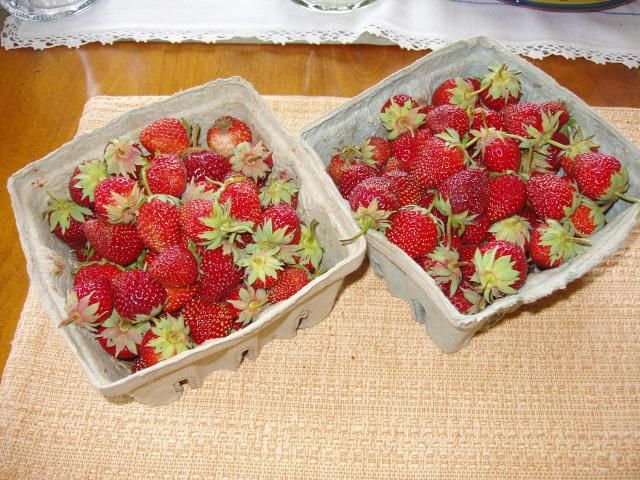
Tonights desert, one of the things that makes it all worthwhile.....
That's it, no more pictures. As always, thanks for following along.
Tim
-
-
Post #22 - June 8th, 2014, 2:14 pmFreezer Pig wrote:My original goal, for becoming a member on LTH Forum, was to be a resource for where food comes from. I hope I'm accomplishing that mission. Feel free to ask anything, if you think it's a stupid question
Tim
Hi Tim,I really enjoy reading the odyssey of your work while watching the animals grow and thrive. Thank you so much for the time you take to post it.
This is probably a stupid question but regarding:Freezer Pig wrote:Comfortable/happy pigs means they gain faster (rate of gain) and eat less doing it (feed conversion), that's a fact that's true in the biggest confinement barns down to our little operation. Pretty much everyone, looks at these numbers to see how good their management practices are.
Does that hold true for factory farms? If not,Why so? Wouldn't faster weight gain and less food costs be better for their financial bottom line?
Artie
-
-
Post #23 - June 8th, 2014, 11:42 pmArtie wrote:......Does that hold true for factory farms? If not,Why so? Wouldn't faster weight gain and less food costs be better for their financial bottom line?
Yes, it does hold true for larger farms. Actually, it is probably a bigger concern for them. When you look at the big picture, if I can make or save an extra dollar a head, it's not a huge deal...... if a farm that's cranking out 10,000+ head/year can make an extra dollar a head, that starts to look like real money on the books.
Now I have a question for you.... what do you consider a factory farm?? Is it just a large barn that holds lots of animals? Is it a barn that is owned by the packing company that will be taking the finished hogs? Is it a bunch of barns in one spot?
I'm not trying to be a smart ass, I would really like to know what the perception of a factory farm is. I think you would be surprised that my grandpa had a factory farm, by many standards. I will give a long winded, NW Ohio response, once I know what to go on. I don't want to spend an hour writing a reply, to find out that any pig that is under a roof, is being tortured.
Anybody else can jump in and add their two cents too, this is why I'm here.........
Tim
-
-
Post #24 - June 9th, 2014, 9:29 amFreezer Pig wrote:Now I have a question for you.... what do you consider a factory farm?? Is it just a large barn that holds lots of animals? Is it a barn that is owned by the packing company that will be taking the finished hogs? Is it a bunch of barns in one spot?
Tim
When I think of factory farms I picture those huge operations that create significant pools of manure and the hazards they present. I believe I saw a news piece on "60 Minutes" years ago that addressed the problem and it's stuck with me ever since. Pork Power:Are Hog Farmers Creating A Waste Hazard?
They're also crammed into pens and not allowed to move freely like yours are. That certainly can't make them happy/comfortable and promote weight gain while reducing feed costs.
-
-
Post #25 - June 9th, 2014, 10:24 pmOK Artie, you gave me what I was asking for. Now I know where I have to start.
You can call it a cop out, but I don't trust 60 Minutes as a credible source for much of anything, especially agricultural issues..... remember the Alar apple scare? (That may have been 20/20, but I lump them all together.) Anyhow, I will try to give another side of the article you sourced.
Yes, modern farms have large lagoons full of manure, it is the most efficient way to deal with it (we'll get into that later). Now, what 60 Minutes didn't say, was these systems are designed to match the facility they are built for. It's not like these farms are just digging a hole in the ground and filling it with poo. They are designed for the number of pigs the farm will have, the number of times they will be emptied in a year, the amount of rainfall for the area (actually 100 year rain events), and there is still a "freeboard" designed in as a cushion, so the level never gets above 3 or 4 feet of the top.
I wouldn't call them a cesspool, there is actually a layer of water on top of most laggons that seals in the brunt of the stink. I'll bet if you talk to any farmer with a lagoon, they will tell you there are ducks and geese nesting, swimming and feeding on those poo lakes.
The worst smells come when it's time to empty the lagoons, they put a big prop in the side and run it like a stick blender, to mix the water with the solids so they can pump it out. I will be the first to admit this smells bad.... sorry, it can't be helped. It only lasts for a few days, and lfe in the country is good again after it's over.
There are regulations in place now, that require a certain number of acres, to apply the waste coming out of a lagoon, based on it's size. If the farmer doesn't own enough land, he will have to have signed contracts, for longterm application of the manure on neighboring farms. In some areas, landowners will pay the lagoon owner to have the manure spread on their land, this is fertilizer folks, real organic fertilzer that everybody seems to think so highly of.
Have lagoons leaked, I'm sure a few have. The big spill in the mid 90's, when a poorly designed one failed, seems to be the one all the anti's keep going back to, was a fluke. They make it sound like they are busting right and left, there were lessons learned from that failure, just like bridge collapses and dams's breaking.
Have wells been polluted with manure in the past, I know they have. I can tell you that back in the late 70's/early 80's, certain types of wells on mom & pop dairy farms were being outlawed, because of contamination issues. This was on farms without lagoons, just old fasioned manure management. I'm not sure 60 minutes isn't blurring the lines between well types and manure manure systems, and something that may have happened once, a long time ago, but it all is frosting on the cake.... since everybody has to eat, but most people don't know where their food comes from, they'll pay attention to the hype.
I will bet, if push came to shove, and there was a way to test the amount of untreated waste coming from humans vs livestock, outside city limits, humans would top the list. The trouble is, fixing that problem requires everybody to spend their own money.... it's easier to blame the hog barn down the road, with a lagoon, that is making the ditches/creeks/rivers/lakes green with algae.
That's it, I've been at this too long. There is a lot more I want to say, but I've said enough. I wish I could sit down with all of you, around a fire, with a cooler full of beers, and talk this out... I hate typing.
We'll go inside the factory farm barns in the next post. I'm tired of typing tonight, and as a matter of fact, I have to go out and clean the barn, the old fashioned way, with a pitchfork and wheel barrow.... just like Grandpa.
Thanks for reading the rant, there will be more tomorrow.....
Tim
-
-
Post #26 - June 10th, 2014, 10:41 pmOK, part two. I'm going to try to keep this short, but I have so many things rolling around in my otherwise empty head, I hope I can get them all out in a clear manner.
First off, alot of what I'm going to say revolves around money & profit. I really want to make it clear that although making money is the main goal of raising livestock commercially, you really have to have a passion to do it. It's kind of like a carreer in Nursing, the money is pretty good, but you're not going to last long if you don't like doing the job. The difference is, the money in hogs isn't that great, so every little bit of good management puts extra cash in your pocket. If you don't want to be raising livestock, your management is going to be lacking, and you won't be in business very long.
Second item you need to know, comfortable happy pigs grow faster and eat less feed doing it (more profit), and are healthier and require less antibiotics (more profit). Anything that causes stress to the pig takes away from his happiness, and you can't fool a pig into not being stressed, he either is or isn't.
Just for the record, the word factory farm kind of makes me/us bristle. The official term is confinement barn. There are three types of production systems, pasture, semi confinement and confinement. Pasture is just like it sounds, the pigs are outside and usually just have a small hut to go in to get out of the weather. Semi confinement would be a solid concrete slab with a building for shelter. the pigs can get outside, but they are not on dirt. Confinement systems are the totally enclosed, enviromentally controlled barns many people call factory farms.
First off is the crowding issue. Pigs in modern finishing barns (being fed for slaughter), aren't crowded into pens. They are able to move around freely and are given enough room to lay down and stretch out without touching one another. Now, if you are comparing it to our barn, they look crowded, the difference is, we have a solid concrete floor and they have slats. When our pigs poo, it lays where it hits, they need more room so they don't have to lay in the waste. In a modern barn, the manure falls through the slats in the floor, so the pigs can lay pretty much anyplace and not be all covered in poo.
One of the things I like to do is go through the barn late at night, when the pigs are sleeping. You can tell by the way they lay if they are healthy and comfortable. If you could walk through a modern confinement barn, the pigs will be sprawled out the same way. They are comfortable and happy.
Another one of the things that is often sited in the evil factory farms is the pigs don't get to lay in mud. Time for a little lesson in pig physiology, other than the end of their nose, pigs don't sweat. They lay in mud because they have to, to cool off. The fact is, if you gave a pig a choice between a clean pool of water and a mudhole, he's going to take the clean water. I have actually seen pigs get out of a mudhole to be sprayed with a garden hose.
This is another problem with pasture systems, the mud is there when it's cool and wet too. The pig is usually muddy and damp when they should be warm and dry, in the spring and fall. Guess what that causes.... stress, and stress means unhappy pigs (but that can't be true, the livestock experts at 60 minutes said they need mud to be happy..... oooops).
Pigs in confinement barns never see sunlight. Well, alot of modern confinement barns have curtain sides. When the weather is warm, the curtain drops and the whole barn is open to outside air, for ventilation. The curtains are opaque, so even when they are up, a fair amount of light comes through. Just to be fair, even in the barns that don't have curtains, the lights are on to simulate daytime. It's not like the pigs are kept in a dark barn, 24 hours a day, until they eat enough to be loaded up for the slaughterhouse.
The last thing I want to say is, in my opinion, pigs today are much better off than they were in grandpa's day. All the do-gooders that want to go back to the way it used to be, when the sun was always shining and farmers wore bib overalls, and the bluebirds flew around their heads as they walked to the fishing hole.
Pigs used to be raised in the darkest, dankest corners of the barn. They were fed nothing but scraps and garbage. If it took 8 months to get them fed out, it was no big deal because you weren't feeding them real feed. The "lucky" pigs, that got to be on pasture, had rings put in their noses, so they wouldn't root up all the vegetation.
Yep, that's the way we need to be doing it, because Grandpa was way more concerned about animal welfare than any farmer today........
That's it, I'm not typing anymore. I hope I've given a few of you something to think about. I know I will never sway the diehard anti factory farm folks, but the facts are the facts. You can get them from the all knowing experts and 60 minutes, who don't know the difference between hay and straw, or trust the people that raise your food for you.
If you do nothing else, watch these two video's. I don't know who these people are, but this is about the best thing I've ever seen, comparing modern livestock barns to the way we used to do it.
Old Way
New Way
Thanks for reading this far, I'll try to get back on track with some pictures tomorrow.
Tim
-
-
Post #27 - June 11th, 2014, 10:12 amIt's been a few days since I posted pictures. Everything is growing around here......
The garden continues to fill in. If we could keep the chickens from shredding the leaves on the cabbage and brussel sprouts, things would look even better.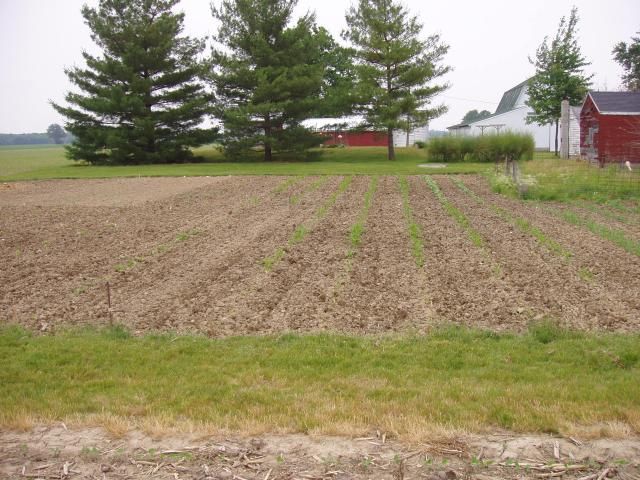
The pigs have settled in and are starting to put on pounds, the weather has been just about perfect for them.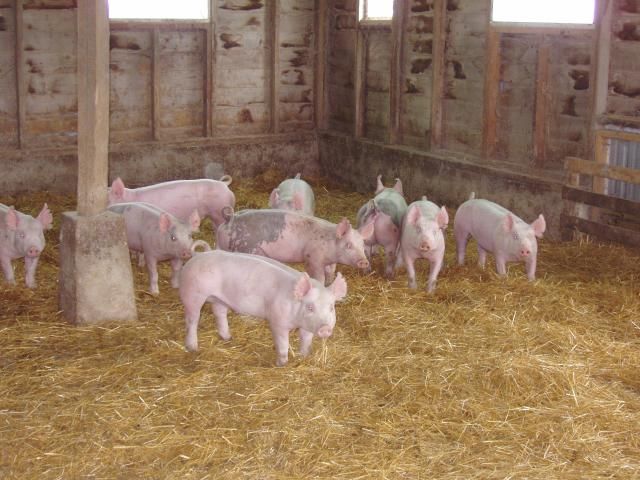
The kittens from the barn have started spending more time exploring, this morning they were on the porch. We have handled all of them, but a couple are still pretty wild. The fifth one ran before I could get close enough for a picture. Mom is under the chair, just watching.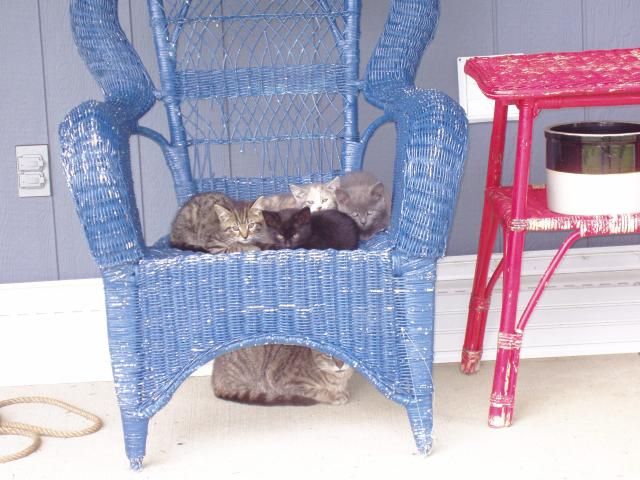
Last shot this morning is the soybean field around the house. This field was planted Memorial Day evening.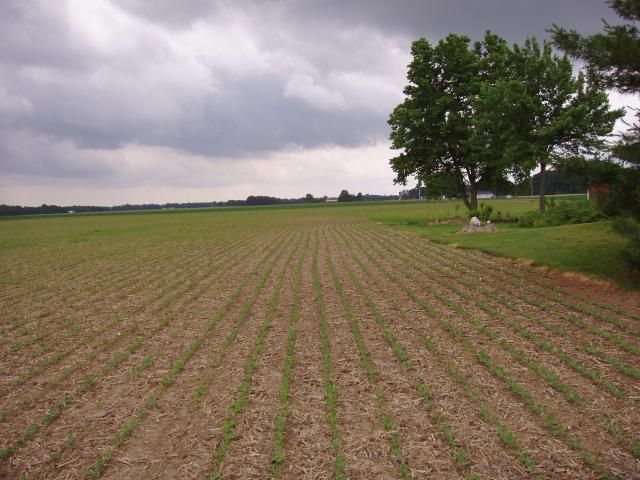
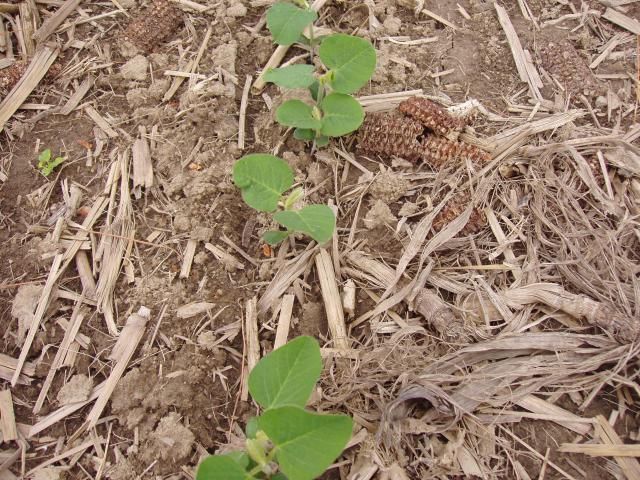
That's it for today.
Tim
-
-
Post #28 - June 11th, 2014, 10:18 amTim-
I am so glad you found your way to this board. I find your perspective incredibly interesting. The photos and narrative are great. I especially liked the shot of the field this time around. -Mary
-Mary
-
-
Post #29 - June 11th, 2014, 10:23 amDitto! Love how the pigs seem so interested in the camera (or the photographer!!)"Knowledge is knowing a tomato is a fruit; wisdom is not putting it in a fruit salad." Miles Kington
-
-
Post #30 - June 13th, 2014, 9:57 amJust a few random pictures today. It started raining right after I took the last ones, Wednesday. We ended up with an inch after dribbling on and off all day. Yesterday was cloudy and misty all day. Today was full sunshine, so I took the camera along to do chores, thinking something interesting would pop up. No go, nothing earth shattering this morning.
I did find 3 pods of peas ready to pick, this is our first pea harvest of the year.
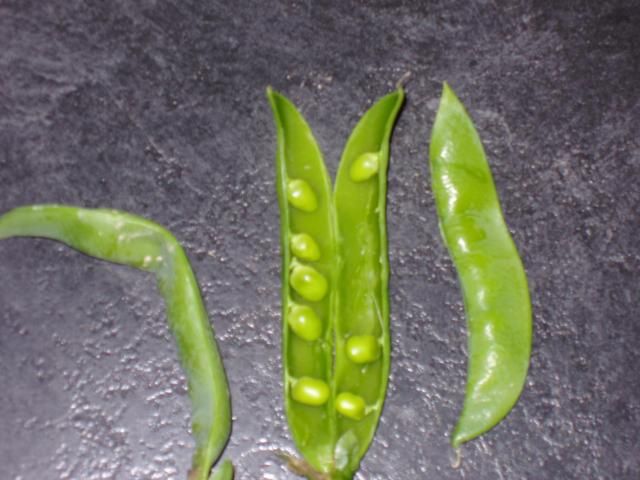
Pigs were up playing when I walked in the barn, it's a little cooler this morning, so they had some extra energy.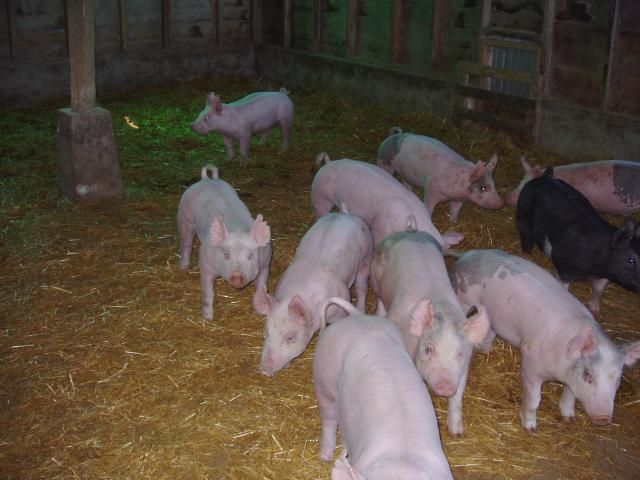
I don't think I've ever posted pictures from inside the chicken coop, so here are a few.
This is the nest box the hens jump up into, to lay their eggs
Usually, there is just an egg or two waiting for us to grab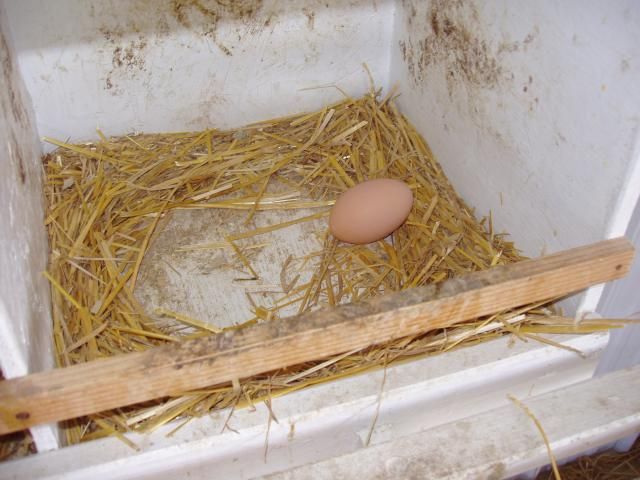
Sometimes, there is a hen that needs to be moved, she eaither just layed one or is just getting ready to, they usually don't stay in the nest for too long.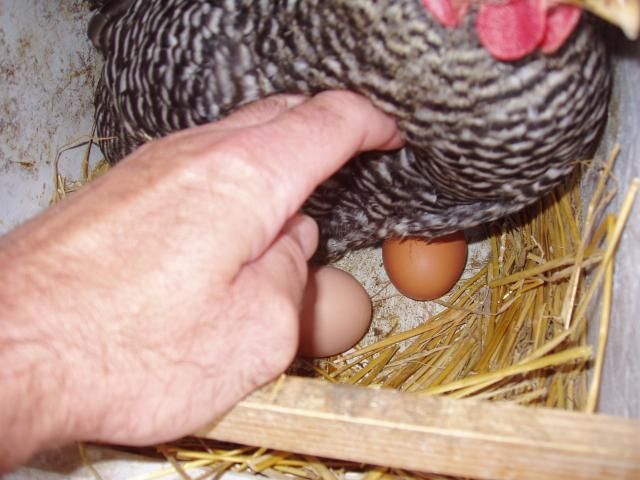
When we put our first group of chickens in a few years ago, it seemed like they were taking forever to lay their first eggs. I thought I'd put a little incentive above the nest boxes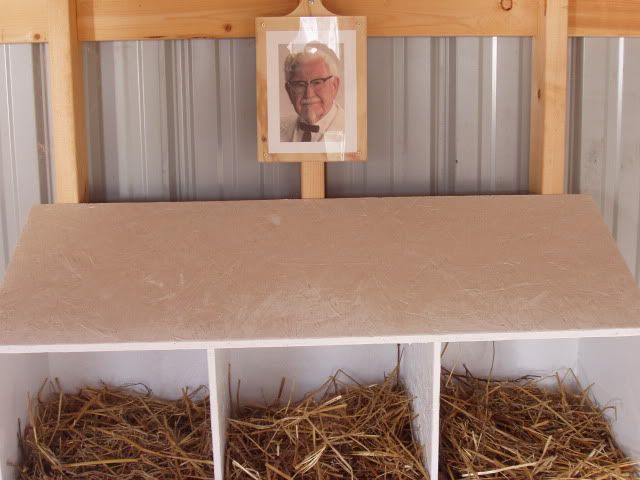
I think that's it for today, next update will be better I hope.
Tim

